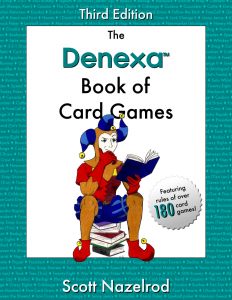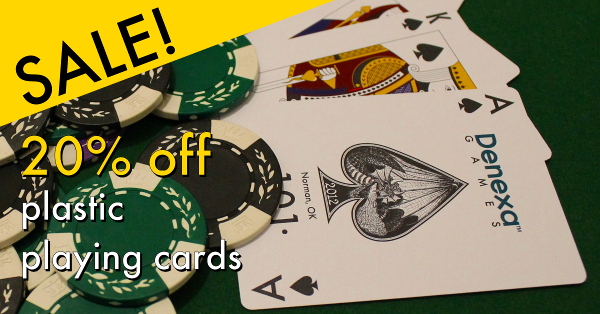Bura
Bura is a trick-taking game for two players. It has the rather unusual feature of allowing a player to lead multiple cards to a single trick. Players can even lead three cards at once to wrest control of the lead from the other player! Another oddity is that the hand ends when a player thinks they have reached a winning point score—and they have no way of knowing they have, other than their memory of the cards they’ve captured!
Bura is a game of Russian origin. It is said to be particularly popular among inmates passing the time, and among ex-convicts who keep on playing it once they get out.
Object of Bura
The object of Bura is to be the first player to correctly declare they have reached a score of 31 or more points in tricks. Another way to win is to hold a bura (three cards of the trump suit).
Setup
Bura is played with a 36-card deck of playing cards. To make such a deck, start with a standard 52-card deck of Denexa 100% Plastic Playing Cards. Then, remove all the 5s through 2s. You’ll be left with just the 6s through aces in each of the four suits.
Bura is typically played with hard scoring. You will need some form of token, such as poker chips, matchsticks, or beans. If you’d like, each of these can represent some amount of real money, which you and your opponent should agreed upon. Give each player the appropriate number of tokens according to their buy-in. If not playing for money, simply give an equal number of tokens to each player.
Each player antes one token. Shuffle and deal three cards to each player. Turn up the next card and place it in the center of the table. The suit of this card is the trump suit. Place the remainder of the deck on top of this card, at a right angle to it, forming the stock.
Card ranking
In Bura, the 10 ranks as the second-highest card, just below the ace. The rest of the cards rank in their usual order. Thus, the full rank of cards is (high) A, 10, K, Q, J, 9, 8, 7, 6 (low).
Game play
The non-dealer leads first. They may lead any card they wish. Their opponent then plays any card they like to the trick; they need not follow suit. If either player plays a trump, the higher trump wins the trick. If both cards played are of the same suit, the higher card takes the trick. When both cards in the trick are of different non-trump suits, the person leading to the trick wins it.
A player may lead as many as three cards, provided they are all of the same suit. The opponent must then play the same number of cards in response. In order to win the trick, the opponent must play cards that would beat each of the cards led if a trick was composed of only those two cards. For example, if a player led a 7 and a 9 in a non-trump suit, the opponent would have to play an 8 or better of the same suit, or a trump, to beat the 7 and a jack or better, or a trump, to beat the 9. If they cannot beat both cards, they lose the trick.
After the winner of a trick has been determined, that player takes the cards and places them face-down in a won-tricks pile in front of them, then leads to the next trick. Then, each player draws from the stock, starting with the winner of the trick and alternating, until their hand once again contains three cards. If there will not be enough cards left in the stock to replenish the hands, the players do not draw at all, instead simply playing on with their hands as they are.
Special leads
If a player has one of the following three-card hands, they may lead them to the trick, even if they did not win the previous trick (and thus would not normally be entitled to lead). These special leading combinations are:
- Bura: Three cards of the trump suit.
- Three aces
- Molodka: Three cards of the same non-trump suit.
To play one of these hands, the player holding it announces it prior to the player who won the last trick leading. If both players hold one of these combinations, a player with a bura takes priority, then one with three aces, then one with a molodka. If they announce the same type of combination, the player who won the last trick retains the right to lead.
When a bura is played, the winner of that trick wins the hand and claims the pot. That is, if only one player has a bura, that player will win the hand. If both players hold a bura, the leader’s opponent must have cards outranking all three cards in the leader’s bura.
For all other combinations, the trick is played out as usual, and game play continues.
Ending the hand
Game play continues, with both players mentally keeping track of the cards they have captured in tricks. Cards score as follows:
- Aces: eleven points.
- 10s: ten points.
- Kings: four points.
- Queens: three points.
- Jacks: two points.
- 9s through 6s: no points.
When a player believes they have reached a score of 31 points, they declare this to their opponent. Note that the won-tricks pile must remain face down at all times, and a player cannot look through it to aid in their declaration. Once the declaration is made, the player turns the cards face up and calculates the score. If they did, in fact, capture 31 or more points in tricks, they win the hand and collect the pot. Otherwise, they must pay into the pot an amount equal to whatever it already contains.
If the players run out of cards before either one makes a declaration of collecting 31 points, the hand is a draw. Neither player wins the pot, and both players ante again to start the next hand.



